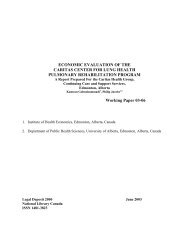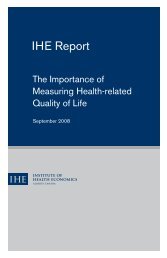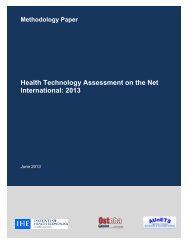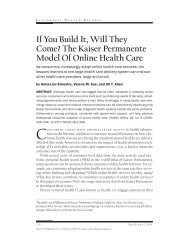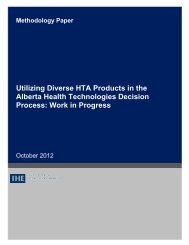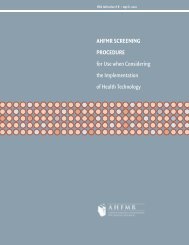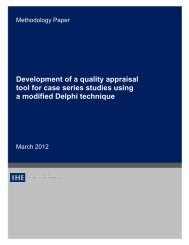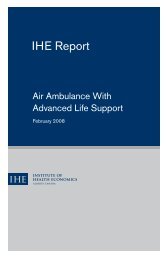Bariatric treatments for adult obesity - Institute of Health Economics
Bariatric treatments for adult obesity - Institute of Health Economics
Bariatric treatments for adult obesity - Institute of Health Economics
- No tags were found...
Create successful ePaper yourself
Turn your PDF publications into a flip-book with our unique Google optimized e-Paper software.
Serious surgical complicationsSurgical procedure comparisons (20 trials, 3391 patients)Early complicationsWound infection: the AGB group had a significantly lower risk than the RYGB group (RD 6.3%; 95% CI:11 to 1.4; one trial with 197 patients).No significant differences in risk <strong>of</strong> anastomotic leak, bowel obstruction, and hernia when compared AGB with RYGB.Late complicationsHernia: AGB groups had a significantly lower risk than RYGB groups (RD 4.5%; 95% CI:8.4 to 0.5; two trials with 248 patients).Stenosis: significantly lower in the AGB group than in the RYGB group (RD 15%; 95% CI: 22 to 8.3; one trial with 197 patients).Slippage or dilatation: AGB groups had a significantly higher risk than RYGB groups (RD 6.1%; 95% CI:1.3 to 11; two trials with 248 patients) andVBG groups (RD 20%; 95% CI: 12 to 28; two trials with 200 patients).Staple-line breakdown: AGB groups had a significantly lower risk than VBG groups (RD 25%; 95% CI:36; 14; two trials with 153 patients).No significant difference in risk <strong>of</strong> bowel obstruction between AGB and RYGB (two trials with 248 patients).Myocardial infarction: no trials reported the comparative incidence <strong>of</strong> myocardial infarction.Laparoscopic versus open approaches (eight trials with 694 patients)Early complicationsWound infection: significantly fewer with laparoscopic RYGB and AGB than with open RYGB and AGB (RD 7%; 95% CI: 11 to 3; six trials with 478patients).No significant differences in risk <strong>of</strong> anastomotic leak, respiratory failure, stenosis, and venous thromboembolic disease between laparoscopic and openRYGB.Late complicationsHernias: significantly fewer with laparoscopic RYGB and AGB than open RYGB and AGB (RD 17%; 95% CI: 27 to 7.6; six trials with 543 patients).Luminal stenosis: significantly fewer with open RYGB than laparoscopic RYGB (RD 8.8%; 95% CI: 17 to 0.9; one trial with 155 patients).No significant differences in risk <strong>of</strong> bowel obstruction and staple line breakdown between laparoscopic and open RYGB.Colquitt et al. 2009 62 Surgery versus non-surgical interventionsTwo trials reported adverse events following surgery: operative interventions, revisional surgery, port site infection, and, following conventionaltherapy: intolerance to medication, acute cholecystitis, need <strong>for</strong> operative intervention, gastrointestinal problems.Surgical procedure comparisonOne trial reported that compared to laparoscopic AGB, laparoscopic isolated sleeve gastrectomy had higher rates <strong>of</strong> early post-operative complicationsbut lower rates <strong>of</strong> late complications requiring surgery.Abbreviations: AGB = adjustable gastric banding; BP = blood pressure; CI = confidence interval; DBP = diastolic blood pressure; GI = gastrointestinal; HG = horizontal gastroplasty;HTA = health technology assessment; MD = mean difference; NA = not available; NNH = number needed to harm; RD = risk difference; RR = relative risk; RYGB = Roux-en-Ygastric bypass; SBP = systolic blood pressure; SR = systematic review; VBG = vertical banded gastroplasty<strong>Bariatric</strong> <strong>treatments</strong> <strong>for</strong> <strong>adult</strong> <strong>obesity</strong> 134



